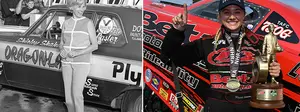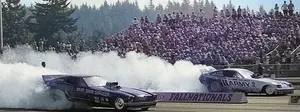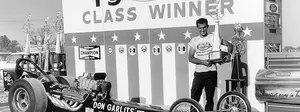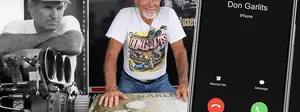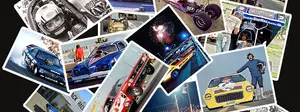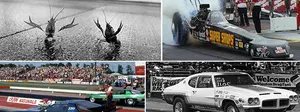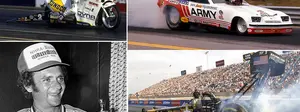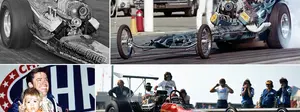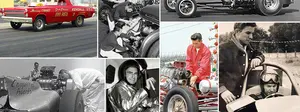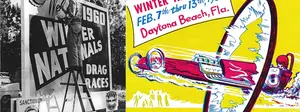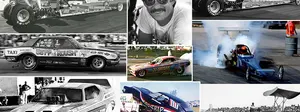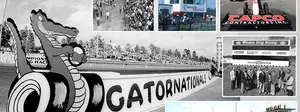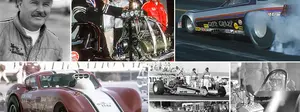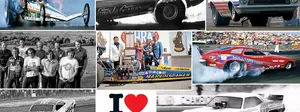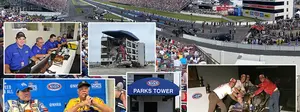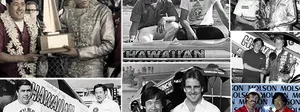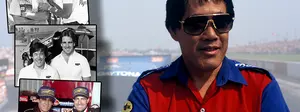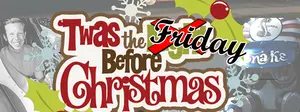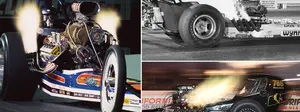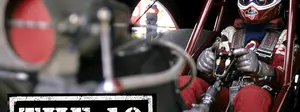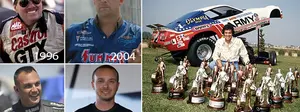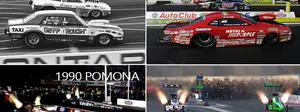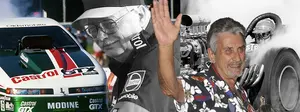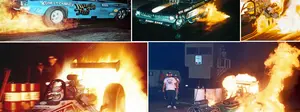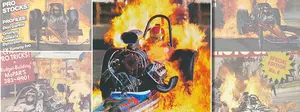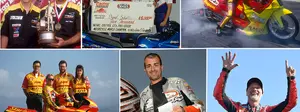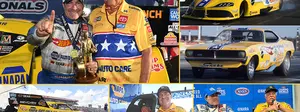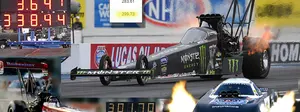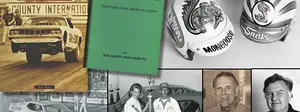Forget “Deflate-gate” — We’ve Got “Lions-gate“
 You do not want to piss off this guy. |
“You’re going to make me pull out what little hair I have left!”
That was the way my Monday began. On the other end of the phone was Larry Sutton, and he didn’t sound very happy.
Sutton, of course, is Southern California’s most famous starter and was at the controls of the Christmas Tree that launched Don Prudhomme and John Wiebe to their controversial dual 6.17s to kick off Lions Dragstrip’s 1972 season at the memorable Grand Premiere event about which I wrote last week.
Sutton began working at Lions as a teenager handing out time slips and by late 1959 was the chief starter, a position he held for the track’s remaining 13 seasons, so, as you can imagine, he holds a very large and soft spot in his heart for “the Beach.” He was good-naturedly bristling this fine morning that I would even suggest that Lions’ clocks could be called into question. We’ve had a good relationship for decades, cemented no doubt by the column I wrote about him here back in 2008 [The Good Guy in the Black Cowboy Hat], but it was still cool to hear him in a bit of a huff.
“Lions was always on the cutting edge when it came to the clocks,” he insisted. “We were part of Chrondek’s testing group, and we were constantly upgrading the clocks to the newest and greatest thing. We always had good clocks. As to any funny stuff with the clocks, it would not happen. There was never a phony e.t. or time slip given at Lions. There was never any B.S.
“Why was Lions always so quick? The track itself was very good. It had a very dense asphalt, like none I’ve ever been on, and we never scraped any rubber off the track. We would take a firehose and Tide and a street sweeper to scrub the track, which is why there was never any oil on the track. VHT was a local manufacturer and helped us out with product; they would give us drums of the stuff [traction compound], and we used it a lot. We were constantly prepping the track, which was not common in those days. The air was so good, and we had the best racers from throughout the nation coming to Lions.”
In the days since the column printed, I’ve also exchanged numerous emails with Wiebe and heard (twice) from two longtime Insider readers whose names should be familiar to longtime column readers: Lions regulars Robert Nielsen and Cliff Morgan. I didn’t think people would accept the challenge of stumping for legit or not.
There are several unknowns that make this a tough call, not the least of which is the lack of reaction times or other incremental times like we know today. The other is Wiebe’s memory, which, while still sharp, still is trying to refire 43-year synapses. It’s his recollection that he was just a few feet behind Prudhomme at the finish line that raises the most eyebrows considering his big starting-line deficit.
“One important thing to remember that current drivers are probably not aware of is that if you are in a rear-engine and see only your opponent’s front tires, you might be very close in the lights,” Wiebe explained. “In a front-engine, you sat so much further back you saw more of the opponent’s car in the lights. That is why my memory bank says about half-a-car.
“The e.t. is probably disputable,” he admits, “but not the close finish.”
 In a classic slingshot vs. rear-engine dragster match, John Wiebe, near lane, defeated Jeb Allen in the semifinals of the 1972 Grand Premiere with a 6.41 best, then improved more than two-tenths to a 6.17 in the final. Possible? |
Nielsen’s debating skills have become legendary, so I knew when he began his email with “There is ABSOLUTELY POSITIVELY no way both of these cars could have run 6.17 in that specific race,” I was in for some interesting reading.
His first position was similar to one that Prudhomme had suggested, that a drop of more than two-tenths in one round (Prudhomme’s previous best was 6.39, Wiebe’s 6.41) was a big hurdle.
“I would like to think that fabled Lions starting-line bite could have caused this dramatic improvement, but that, too, is unreasonable. I would challenge anyone to come up with another example of this type of performance gain for one round of racing only to have the cars then go back to what they were running after that single round. In drag racing, that just plain does not happen.
“All right, that is the subjective argument. Now, let us look at this particular run from a more analytical perspective and how the race actually played out. For sake of argument, let us first assume one of the cars did in fact actually run a 6.17. If we look at the starting-line photographs, they clearly show Wiebe being dead late off the starting line. Wiebe was able to nearly make up this starting-line deficit by the time they got to the finish line (confirmed by Wiebe’s recollection: ‘I chased him down and actually thought that I had won based on how much of his car I could see at the finish line.’)
“In order for Wiebe to make up the starting deficit, he would have had to run a faster elapsed time than Prudhomme. Therefore, there is absolutely no way Wiebe and Prudhomme could have run almost identical elapsed times under this scenario. Prudhomme’s elapsed time had to have been slower than Wiebe’s!”
 |
Because reaction times and 60-foot times were not recorded (according to Nielsen, Lions never had reaction-time clocks let alone incremental timers), he put together some assumptions based on estimated wheelbase and 60-foot clockings (since the best photo shows Prudhomme about 60 feet into his run).
Nielsen estimated Wiebe’s wheelbase at 240 inches and did some fancy calculating about how long it would take his car to cover that first 60 feet, and although the numbers he used were not accurate, he estimated that Wiebe would have had to run more than two-tenths quicker than Prudhomme to make up the distance shown in the photograph.
(Wiebe does not remember the exact length of his car, so I did some comparative shopping. Don Garlits writes in his book, Don Garlits and His Cars, that his Swamp Rat 13 slingshot, built in late 1969, was 220 inches, and multiple sources report that Swamp Rat 14, his first rear-engine car, was — surprise — only 215 inches in wheelbase; Wiebe’s slingshot was built in 1970 by Roy Fjastad at SPE, so I think 240 might be a bit of a stretch, so to speak.)
Flipping the script the other way and assuming that Wiebe did really run 6.17 (which he has said he believes) means Prudhomme would have run somewhere near his previous runs (low 6.30s to mid-6.40s) for him to surrender his big lead so that they arrive together at the finish line.
Finally, Nielsen posits the theory that Wiebe’s low slung chassis allowed the elapsed time clocks to start when the rear tires cleared the beams (about a 20-foot advantage), which his (albeit flawed) math again showed to be more than two-tenths of a second, meaning that if Prudhomme actually did run 6.17, Wiebe ran somewhere back in the low- to mid-6.40s, which was what he had run in previous rounds.
(Wiebe’s response: “I don't think I would argue with the guy. Some of his numbers might be inflated and maybe not; a lot of fans are smarter than a lot of racers I have discovered.”)
 This whole thread is wearing me out. What about you, "Kansas John"? Thought so. |
I sent Nielsen’s theories to Morgan, another regular attendee at Lions shows, and he weighed in, “Wiebe's car wasn't 240-inch chassis, probably more like 200 inches, give or take. Front-motor cars were not that long, and 220 inches is about the most I remember for those cars. The 60-foot time would have been way slower than today’s cars, maybe 1.5 seconds (??). I agree that ‘Snake’ put a car length on Wiebe at the start, so say he was maybe a tenth better off the line. So for ‘the Weeb’ to make that time up, he would have had to run real close to .10 quicker than ‘Snake’, just to be even with him at the finish. Did the fact that Wiebe's car didn't have the front body on it have anything to do with the times? Back then, the front wheels were what broke the beams, both at the start and finish.
“I was at that race, and, of course, the final round is what stands out in my mind. I look back at it now and think, yeah, they could have run those times, but back then I thought they were maybe bogus. I always thought Lions' clocks were honest, but this could have been a malfunction. My vote would be ‘bogus times,’ just based on neither driver even coming close to backing up the 6.17s at that event.
“I think they both had the power to run 6.17 regardless of chassis style. It was getting the power to the ground that was the ‘problem’ then. Interesting that 1972 started off with world record of 6.21, set by Garlits at the 1971 Nats (yes, I know he had a staggered wheelbase), and then 6.17 at Lions, 6.15, 243 by Garlits at the Gators, then a bunch of 6.0s by various racers, and finally the first five by either Tommy Ivo or Mike Snively, and finally, that 5.91 by Don Moody at the Supernats that year. BIG drop in e.t.s, from 6.21 to 5.91. Interesting time in drag racing history.”
(What’s missing from this discussion is the proverbial “hot dog wrapper blowing through the lights” and triggering the e.t. beam prematurely, and although I did receive one anecdotal story that claims, in a roundabout way, that’s what happened, after a lot of consideration, I respectfully decided that what this mystery didn’t need was a grassy knoll.)
Forget “Deflate-gate” — we’ve got Lions-gate on our hands here.
I asked Sutton about the possibility of low-slung cars messing with the timing lights or other trickery that might have come into play from time to time.
“There were always guys trying stuff, like hanging things below their cars; I caught a lot of people doing that,” he remembers. “I would always look at the cars very carefully, and I’d watch the beams as they backed up from their burnouts, and if they didn’t just quickly flash, I knew something was hanging below the car. One guy was really good at it; he was always running fast and winning and never red-lighted. Then I noticed that he would always wait until I turned away to do his dry hop. When I wasn’t looking, he would flip a cog and lower the car. Guys were always trying things.
“I watched that stuff like a hawk, every bit of it. Parachutes, helmets, too low — everything. I was fanatic about it, not just for safety but so we could have a good, fair race. I wasn’t just up there to push a button.”
So we’re ready to move on, right? Wiebe is. Well, except for this one race in 1976.
“Remember when I was runner-up to Tharp at Indy and they said I red-lighted? So did all the other Pro category drivers, and they were all in the left lane as was I with the sun low in the west. We need to speculate on that one.”
Indy-gate, anyone?


